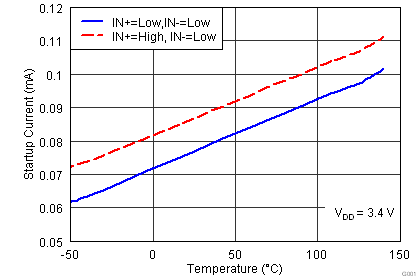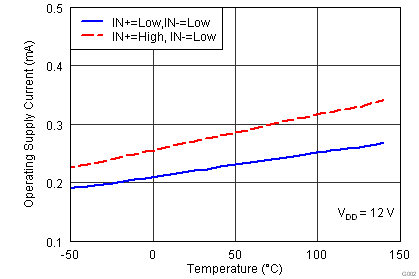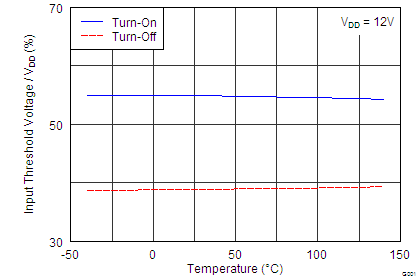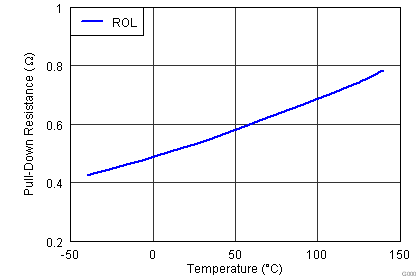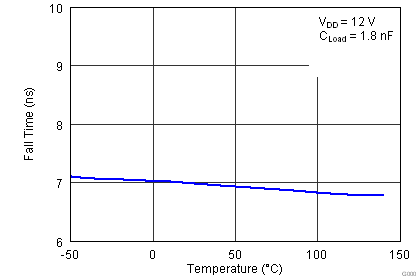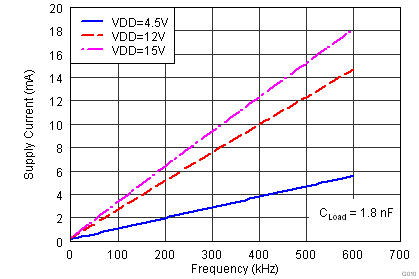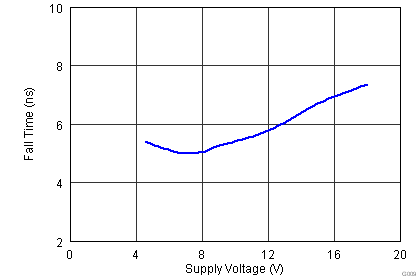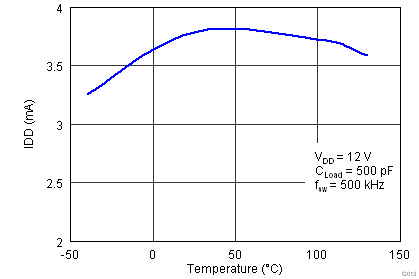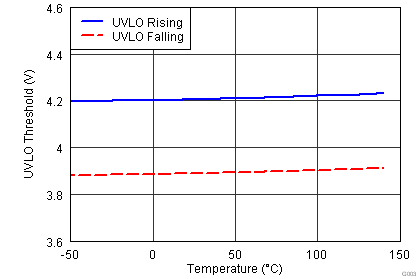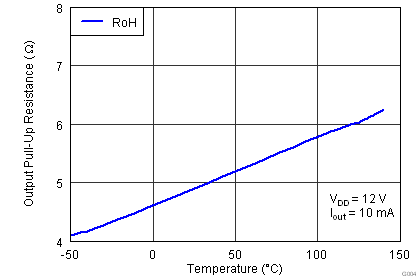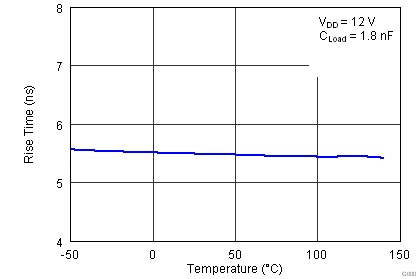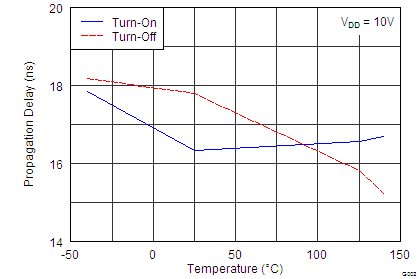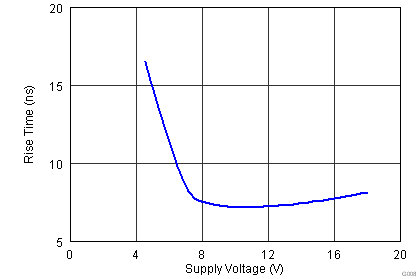SLUSB33A May 2012 – December 2014 UCC27518 , UCC27519
PRODUCTION DATA.
- 1 Features
- 2 Applications
- 3 Description
- 4 Revision History
- 5 Description (continued)
- 6 Device Comparison Table
- 7 Pin Configuration and Functions
- 8 Specifications
- 9 Detailed Description
- 10Application and Implementation
- 11Power Supply Recommendations
- 12Layout
- 13Device and Documentation Support
- 14Mechanical, Packaging, and Orderable Information
Package Options
Mechanical Data (Package|Pins)
- DBV|5
Thermal pad, mechanical data (Package|Pins)
Orderable Information
8 Specifications
8.1 Absolute Maximum Ratings(1)(2)(3)
over operating free-air temperature range (unless otherwise noted)| MIN | MAX | UNIT | ||
|---|---|---|---|---|
| Supply voltage | VDD | –0.3 | 20 | V |
| OUT voltage | –0.3 | VDD + 0.3 | ||
| Output continuous current | IOUT_DC (source/sink) | 0.3 | A | |
| Output pulsed current (0.5 µs) | IOUT_pulsed(source/sink) | 4 | ||
| IN+, IN-(4), EN | –0.3 | 20 | V | |
| Operating virtual junction temperature, TJ | –40 | 150 | °C | |
| Lead temperature | Soldering, 10 sec. | 300 | ||
| Reflow | 260 | |||
| Storage temperature, Tstg | –65 | 150 | ||
(1) Stresses beyond those listed under Absolute Maximum Ratings may cause permanent damage to the device. These are stress ratings only and functional operation of the device at these or any other conditions beyond those indicated under Recommended Operating Conditions is not implied. Exposure to absolute-maximum-rated conditions for extended periods may affect device reliability.
(2) All voltages are with respect to GND unless otherwise noted. Currents are positive into, negative out of the specified terminal. See Packaging Section of the data sheet for thermal limitations and considerations of packages.
(3) These devices are sensitive to electrostatic discharge; follow proper device handling procedures.
(4) Maximum voltage on input pins is not restricted by the voltage on the VDD pin.
8.2 ESD Ratings
| VALUE | UNIT | |||
|---|---|---|---|---|
| V(ESD) | Electrostatic discharge | Human body model (HBM), per ANSI/ESDA/JEDEC JS-001(1) | ±4000 | V |
| Charged-device model (CDM), per JEDEC specification JESD22-C101(2) | ±1000 | |||
(1) JEDEC document JEP155 states that 500-V HBM allows safe manufacturing with a standard ESD control process.
(2) JEDEC document JEP157 states that 250-V CDM allows safe manufacturing with a standard ESD control process.
8.3 Recommended Operating Conditions
over operating free-air temperature range (unless otherwise noted)| MIN | NOM | MAX | UNIT | |
|---|---|---|---|---|
| Supply voltage range, VDD | 4.5 | 12 | 18 | V |
| Operating junction temperature range | –40 | 140 | °C | |
| Input voltage, (IN+ and IN–) and Enable (EN) | 0 | 18 | V |
8.4 Thermal Information
| THERMAL METRIC | UCC27518 | UCC27519 | UNIT | |
|---|---|---|---|---|
| SOT-23 DBV | SOT-23 DBV(1) | |||
| 5 PINS | 5 PINS | |||
| RθJA | Junction-to-ambient thermal resistance(1) | 217.6 | 217.6 | °C/W |
| RθJC(top) | Junction-to-case (top) thermal resistance(1) | 85.8 | 85.8 | |
| RθJB | Junction-to-board thermal resistance(1) | 44.0 | 44.0 | |
| ψJT | Junction-to-top characterization parameter(1) | 4.0 | 4.0 | |
| ψJB | Junction-to-board characterization parameter(1) | 43.2 | 43.2 | |
(1) For more information about traditional and new thermal metrics, see the IC Package Thermal Metrics application report, SPRA953.
8.5 Electrical Characteristics
VDD = 12 V, TA = TJ = -40 °C to 140 °C, 1-µF capacitor from VDD to GND. Currents are positive into, negative out of the specified terminal.| PARAMETER | TEST CONDITIONS | MIN | TYP | MAX | UNIT | ||
|---|---|---|---|---|---|---|---|
| BIAS CURRENTS | |||||||
| IDD(off) | Startup current | VDD = 3.4 V | IN+ = VDD (UCC27519), IN- = GND (UCC27518) |
51 | 85 | 123 | µA |
| IN+ = GND (UCC27519), IN- = VDD (UCC27518) |
51 | 70 | 103 | ||||
| UNDERVOLTAGE LOCKOUT (UVLO) | |||||||
| VON | Supply start threshold | TA = 25 °C | 3.85 | 4.20 | 4.57 | V | |
| TA = -40 °C to 140°C | 3.80 | 4.20 | 4.67 | ||||
| VOFF | Minimum operating voltage after supply start | 3.45 | 3.9 | 4.35 | |||
| VDD_H | Supply voltage hysteresis | 0.19 | 0.3 | 0.45 | |||
| INPUTS (IN+, IN–) | |||||||
| VIN_H | Input signal high threshold | VDD = 4.5 V | 55 | 62 | %VDD | ||
| VIN_L | Input signal low threshold | 31 | 39 | ||||
| VIN_HYS | Input signal hysteresis | 16 | |||||
| VIN_H | Input signal high threshold | VDD = 12 V | 55 | 59 | |||
| VIN_L | Input signal low threshold | 31 | 39 | ||||
| VIN_HYS | Input signal hysteresis | 16 | |||||
| VIN_H | Input signal high threshold | VDD = 18 V | 55 | 58 | |||
| VIN_L | Input signal low threshold | 35 | 38 | ||||
| VIN_HYS | Input signal hysteresis | 17 | |||||
| ENABLE (EN) | |||||||
| VEN_H | Enable signal high threshold | VDD = 12 V | 2.1 | 2.3 | V | ||
| VEN_L | Enable signal low threshold | 1.00 | 1.25 | ||||
| VEN_HYS | Enable hysteresis | 0.86 | |||||
| SOURCE/SINK CURRENT | |||||||
| ISRC/SNK | Source/sink peak current(1) | CLOAD = 0.22 µF, FSW = 1 kHz | -4/+4 | A | |||
| OUTPUTS (OUT) | |||||||
| VDD-VOH | High output voltage | VDD = 12 V IOUT = -10 mA |
50 | 90 | mV | ||
| VDD = 4.5 V IOUT = -10 mA |
60 | 130 | |||||
| VOL | Low output voltage | VDD = 12 IOUT = 10 mA |
5 | 11 | |||
| VDD = 4.5 V IOUT = 10 mA |
6 | 12 | |||||
| ROH | Output pullup resistance(2) | VDD = 12 V IOUT = -10 mA |
5.0 | 7.5 | Ω | ||
| VDD = 4.5 V IOUT = -10 mA |
5.0 | 11.0 | |||||
| ROL | Output pulldown resistance | VDD = 12 V IOUT = 10 mA |
0.5 | 1.0 | |||
| VDD = 4.5 V IOUT = 10 mA |
0.6 | 1.2 | |||||
(1) Ensured by Design.
(2) ROH represents on-resistance of P-Channel MOSFET in pullup structure of the UCC27518 and UCC27519's output stage.
8.6 Switching Characteristics
over operating free-air temperature range (unless otherwise noted)| PARAMETER | TEST CONDITIONS | MIN | TYP | MAX | UNIT | |
|---|---|---|---|---|---|---|
| tR | Rise time(1) | CLOAD = 1.8 nF | 8 | 12 | ns | |
| tF | Fall time(1) | CLOAD = 1.8 nF | 7 | 11 | ||
| tD1 | IN+ to output propagation delay(1) | VDD = 10 V 7-V input pulse, CLOAD = 1.8 nF |
6 | 17 | 25 | |
| tD2 | IN- to output propagation delay(1) | VDD = 10 V 7-V input pulse, CLOAD = 1.8 nF |
6 | 17 | 24 | |
| tD3 | EN to output high propagation delay(1) | CLOAD = 1.8 nF, 5-V enable pulse | 4 | 12 | 16 | |
| tD4 | EN to output low propagation delay(1) | CLOAD = 1.8 nF, 5-V enable pulse | 4 | 12 | 19 | |
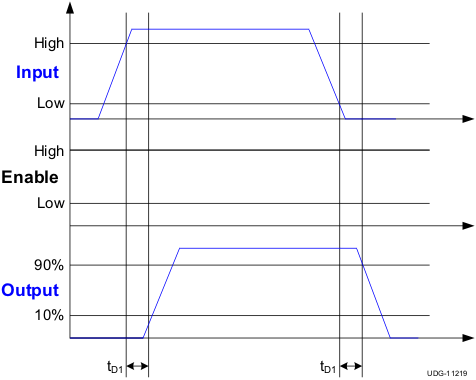
(In+ Pin, UCC27519)
Figure 1. Noninverting Configuration
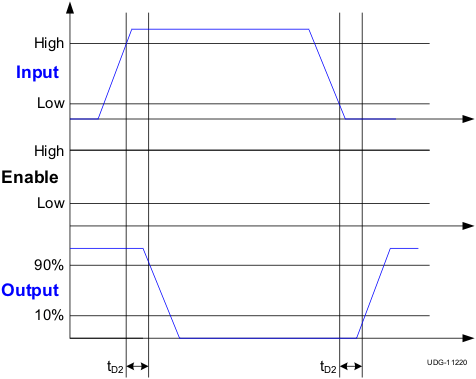
(In– Pin, UCC27518)
Figure 2. Inverting Configuration
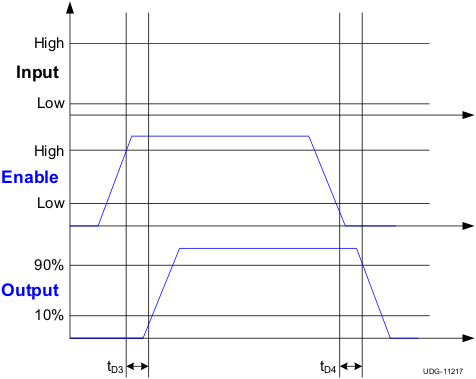
(Noninverting Configuration, UCC27519)
Figure 3. Enable and Disable Function
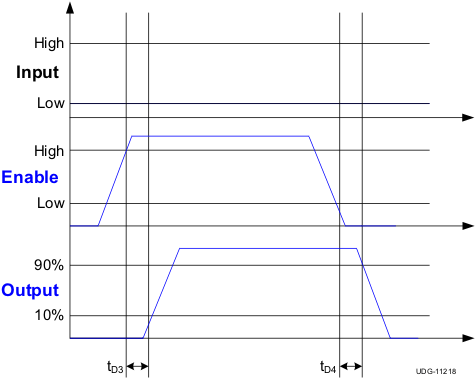
(Inverting Configuration, UCC27518)
Figure 4. Enable and Disable Function
8.7 Typical Characteristics
